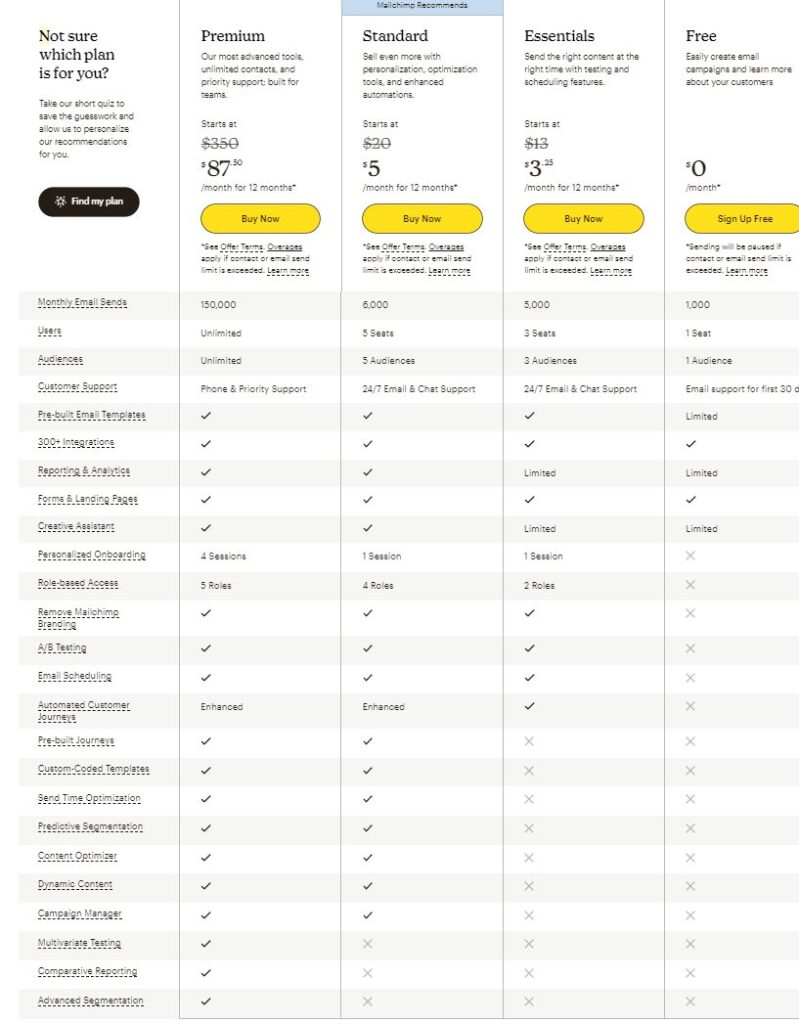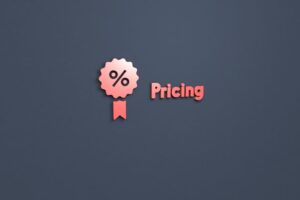What is Price Anchoring?
Price anchoring is a pricing strategy that involves setting an initial price point, known as an anchor, to influence the perception of subsequent prices. The anchor serves as a reference point or comparison for evaluating the value of other prices. The anchor can also be a competitor’s price or a higher-priced version of a product.
This approach is a powerful psychological pricing strategy businesses use to influence consumer behavior and shape purchasing decisions. The main idea behind price anchoring is that people tend to rely heavily on the first piece of information they receive when making judgments or decisions.
By presenting a high initial price point, subsequent prices will appear comparatively lower or more favorable, leading consumers to perceive them as better deals or more reasonable.
For example, imagine walking into a clothing store and spotting a stylish jacket with a price tag of $200. It seems expensive, right? But then, you notice a sign nearby indicating that the original price was $400, now slashed in half. Suddenly, that $200 price tag doesn’t seem so high anymore.
Backed By Scientific Research
In a well-known study, researchers Greg Northcraft and Margaret Neale conducted an experiment involving real estate agents and amateurs. Both participating groups were asked to evaluate a house and provide their estimates for its appraisal value and purchase price.
During the study, the researchers manipulated the list price of the house, providing both high and low anchor prices. The study revealed that all of them were influenced by the anchor price regardless of professional experience.
So, how can you use price anchoring to your advantage? The following sections outline real-life examples and steps to implement this tactic in your business.

Price Anchoring Examples
Realizing the efficacy of the price anchor strategy, several companies have adopted it in their business model. Here are some price anchoring examples:
Monday.com
We have here, the pricing plan of Monday.com, a project management software that helps businesses plan, track, and manage productivity. Users will most likely subscribe to the standard plan since it looks more appealing and offers significantly better features than the basic plan.
The common perspective at this point is that $2 is a small amount to spare for additional features, compared to $6 for the pro plan. It also leverages on the power of anxiety that accompanies decision-making, especially when presented with many options. The standard package was tagged the “most popular” option amongst users. This, in turn, will make a newbie, particularly an indecisive one, opt for the suggested package.
MORE: Learn about Monday.com’s various pricing options.
MailChimp
MailChimp is a popular email marketing software that helps businesses to create and execute successful email marketing campaigns. Notice the wide gap between the premium and standard pricing even though the features and capabilities of both plans are almost the same. The extreme premium aims to serve as an “anchor,” guiding customers to the standard package.

MORE: Mailchimp pricing review.
Retail and eCommerce Sites
Slashed prices are popular on eCommerce platforms like Amazon, Shopify, and Alibaba. On these platforms, you may see the original or list price of a product, often struck through or highlighted, to establish a reference point for comparison. This price is intended to create a perception of a discount.
When to Use a Price Anchoring Strategy
Price anchoring yields variable results across various industries and business types. Here are some situations where pricing anchoring is highly effective:
Introducing a New Product
When launching a new product, setting a higher anchor price can create a perception of higher quality or exclusivity. Even if you plan to offer discounts or promotions later, starting with a higher price helps establish a premium perception and positions the product as a desirable option.
Customers who were initially hesitant due to the higher price may be more inclined to make a purchase when presented with a limited-time discount, feeling that they are getting a better deal.
MORE: Price anchoring works well with odd even pricing.
Upselling and Cross-selling
If you have a range of products or services at different price points, using price anchoring can help guide customers toward higher-priced options.
By showcasing the features and benefits of the premium option alongside the initial product, you can emphasize the added value the customer will receive by upgrading. Highlighting the key differentiators and demonstrating the superior value of the premium option compared to the base product helps justify the higher price.
Bundling and Package Deals
Price anchoring can be effective when offering bundled products or package deals. Begin by establishing the anchor price to reflect the sum of the prices of the individual items included in the bundle.
Then display the discounted bundle price alongside the anchor price. The bundle price should be lower than the anchor price to create a perception of a fair bargain. This difference between the anchor price and the bundle price reinforces the attractiveness of the bundle offer.
Premium Positioning
You can use price anchoring to position your brand or product as high-end or premium. To do this, you have to set a high initial price point that’s higher than the prices of similar offerings in the market. This way you create a perception of exclusivity and quality, positioning your product or service as a premium option.
While the anchor price is higher, ensure that the value customers receive justifies the premium. Highlight the long-term cost savings, enhanced experience, convenience, or additional services that come with choosing your premium offering.
Price Negotiations
Price anchoring can also be useful during price negotiations. By initially setting a higher price, you create room for negotiation while still maintaining a satisfactory price point. The anchor price can serve as a starting point for the negotiation process.
MORE: What is Tiered Pricing Strategy?
When Price Anchoring Doesn’t Work
While price anchoring can be a powerful pricing strategy, there are situations where it may not work as effectively. Here are some scenarios where price anchoring may not yield the desired results:
Savvy Buyers
Savvy buyers tend to be more informed about pricing strategies and are less likely to be swayed solely by anchor prices. They often conduct thorough research, compare options, and evaluate products or services based on multiple factors beyond the initial price.
They are more inclined to focus on the overall value proposition, quality, reputation, and long-term benefits rather than solely relying on anchor prices.
Price-sensitive Markets
In markets where consumers are highly price-sensitive or have limited purchasing power, using a high anchor price may discourage them from making a purchase altogether.
In such situations, other pricing strategies like penetration pricing (setting low prices to gain market share), or value pricing (emphasizing the value and benefits of the product or service) may be more effective.
It is crucial to consider the economic context and the affordability of your products or services when applying price anchoring.
MORE: Learn about geographical pricing strategy.
Unique or Innovative Products
When introducing products that are highly distinctive or groundbreaking in the market, customers often base their evaluation on factors beyond price alone. They consider the novelty, features, performance, and perceived value of the product, rather than relying solely on anchor prices.
The value proposition of these products extends beyond price. Customers are often willing to pay a premium for the exclusivity and benefits they offer.
Familiar Products
When customers are already familiar with a product or have established reference prices in mind, the impact of price anchoring diminishes. They have prior knowledge of the typical price range for the product and may base their purchasing decisions on other factors besides the anchor price.
Instead of relying heavily on price anchoring in this case, companies may consider focusing on value differentiation, customer service, and product features to attract and retain customers.
MORE: What is charm pricing, and how can it help your business?
How to Implement a Price Anchor Strategy
Implementing a price anchor strategy involves several key steps. Here are a few steps to implement a price anchor strategy effectively:
1. Understand Your Market and Customers
Conduct market research to understand your target market, their preferences, buying behavior, and price sensitivity. Identify the key factors that influence their purchasing decisions and determine the range of prices they are willing to consider.
Web scraping is an excellent way to gather large amounts of data quickly for market analysis. Identify the websites or platforms that contain the data you require, then select a suitable web scraping tool for the process. Here’s how to choose the best proxies for your research.
2. Determine Your Value Proposition
A unique selling point is a fundamental part of a product description that sells. Identify the key features, attributes, or benefits that differentiate your product or service from competitors. These could be specific functionalities, superior quality, customization options, convenience, speed, or cost savings.
Summarize these details in a concise and compelling statement and make sure it resonates with your target market
3. Set Your Anchor Price
Check your competitor’s pricing to understand the pricing range for similar products or services in the market. Then, consider your unique value to determine the perceived value of your offering. Also, evaluate your production or service delivery costs, overheads, and desired profit margins.
Finally, test different price points to assess customer responses and demand elasticity. Select an anchor price that is higher than your desired selling price but still within a reasonable range for your target market.
4. Provide Comparative Pricing
Present a visual representation of the pricing options side by side. Use clear and visually appealing graphics or tables to showcase the different price points and highlight the savings or advantages of choosing a specific option.
For retailers, it might be an excellent idea to display the original or higher price alongside the current discount price with a strike-through format. Consider using attractive colors like red.
5. Monitor and Adjust
Finally, monitor customer response, market conditions, and competitors’ pricing to evaluate the effectiveness of your price anchor strategy. Review your sales data and performance metrics to assess the impact of your new pricing strategy. Look for changes in sales volume, revenue, or average order value.
Collect customer feedback regarding pricing to determine their preferences, satisfaction levels, and potential areas for improvement. Keep a close watch on your competitors too and be prepared to adjust your price anchoring strategy based on the feedback and data you gather.
Key Takeaways
Remember, implementing a price anchor strategy is not a one-size-fits-all approach. Consider the specific market dynamics, customer preferences, and unique characteristics of your products or services when deciding whether to use a price anchoring strategy.
Tailor your strategy to your specific circumstances and be willing to adapt and refine your approach over time. You may need the intervention of different types of tools along the way, SaaSGenius is an excellent place to find all the resources you need to implement a successful SaaS pricing strategy.










